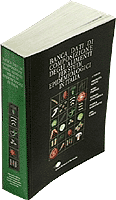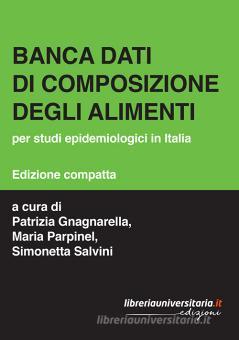The BDA project
 Thanks to funding by the Italian Association for Research on Cancer (AIRC), in collaboration with various research groups in Italy, the “Food Composition Database for Epidemiological Studies in Italy”, by Salvini, Parpinel, Gnagnarella, Maisonneuve, Turrini, was published in 1998. The project was started because of the need of epidemiologists for a large database with information about the most important nutrients in the main food items consumed in our country. The role of diet in the prevention and as a cause of chronic disease can be assessed by large epidemiological studies: thus, food composition databanks are needed to transform dietary consumption information into nutrients.
Thanks to funding by the Italian Association for Research on Cancer (AIRC), in collaboration with various research groups in Italy, the “Food Composition Database for Epidemiological Studies in Italy”, by Salvini, Parpinel, Gnagnarella, Maisonneuve, Turrini, was published in 1998. The project was started because of the need of epidemiologists for a large database with information about the most important nutrients in the main food items consumed in our country. The role of diet in the prevention and as a cause of chronic disease can be assessed by large epidemiological studies: thus, food composition databanks are needed to transform dietary consumption information into nutrients.
The database was compiled according to a well defined methodology, starting from food composition data of the National Nutrition Institute (INN) of Rome (1989), from other Italian and foreign sources (Fidanza, McCance&Widdowson’s, USDA) and from scientific papers.
BDA provides the composition in terms of energy and nutrients (water, macronutrients, 6 minerals, and 11 vitamins) for 788 food items. The printed version includes methodological chapters and individual information sheets. It is possible to download the volume of the first version in pdf format (download book) and to request the updated data file in text format (ascii), by sending a request by e-mail.
BDA has continued to evolve and update, adapting to the guidelines of the international non-profit association EuroFIR AISBL (Association Internationale Sans But Lucratif), that originates from the European project EuroFIR (European Food Information Resource), a network of excellence focusing on food information resources.
The first two updates were released online in 2008 and 2015:
BDA 2008 – The following food groups were updated: milk and milk products; meat and fish (fresh or preserved); alcoholic and non alcoholic beverages; eggs; fats. Within these categories, compared to the 1998 version, the following components were added: aminoacids, some fatty acids (in particular omega-3), sugars, minerals and trace elements (magnesium, copper, selenium, chlorine, iodine, manganese, sulphur), vitamins (pantothenic acid, biotin, vitamin B12).
BDA 2015 – The following food groups were updated: fresh fruit and berries, cooked or canned fruit, dried fruit and seeds, fruit flours, fruit juices and drinks. Within these categories, compared to the 1998 version, the following components were added: aminoacids, some fatty acids (in particular omega-3), sugars, minerals and trace elements (magnesium, copper, selenium, chlorine, iodine, manganese, sulphur), vitamins (pantothenic acid, biotin, vitamin B12, vitamin K).
BDA 2022 – The latest 2022 update was released in both paper and e-book formats, as well as online. It provides the energy and nutrient composition (water, macronutrients, 13 minerals, 15 vitamins, 16 single and 5 total fatty acids, 18 aminoacids, 6 soluble carbohydrates) for 1109 foods.

The volume “Food Composition Database for Epidemiological Studies in Italy. Compact edition”, edited by Patrizia Gnagnarella, Maria Parpinel and Simonetta Salvini, published by LibreriaUniversitaria.it, represents the updated 2022 version of the online database, revised in the composition data of the group “Cereals and cereal products“, specifically: “Cereals, flours, pasta, bread, crackers, rusks”, “Sweets, sugar, jams, ice creams”, “Brioches, cookies, puddings, cakes”. In addition to the food composition tables – four tables: Principal Components and Energy; Minerals and Vitamins, Fatty Acids; Amino acids – there is a chapter on the dietary assessment tools, another on the compilation methodology and the last one on the definition of the food components included.
An appendix also reports the composition data relating to soluble carbohydrates for a subgroup of foods. Complete the text the index of names of foods and nutrients in Italian and English.
It is possible to purchase the volume and e-book at this link.
Furthermore, BDA coordinated NUTRIRETE.lab (2014-2020), a network to collect food composition data, produced by public and private laboratories developed as part of Work Package 4 (WP4) of the Operating Unit 4 (OU 4 – SIAGRO) of the QUALIFU project (Qualità Alimentare e Funzionale), funded by the Ministry of Agriculture and Forestry (MIPAAF) (M. D.2087/7303/09).
